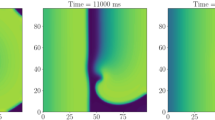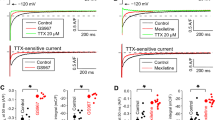Abstract
Aim:
To examine the electrophysiological effects of sophocarpine on action potentials (AP) and ionic currents of cardiac myocytes and to compare some of these effects with those of amiodarone.
Methods:
Langendorff perfusion set-up was used in isolated guinea pig heart, and responses to sophocarpine were monitored using electrocardiograph. Conventional microelectrode, voltage clamp technique and perforated patch were employed to record fast response AP (fAP), slow response AP (sAP) and ionic currents in guinea pig papillary muscle or rabbit sinus node cells.
Results:
Tachyarrhythmia produced by isoprenaline (15 μmol/L) could be reversed by sophocarpine (300 μmol/L). Sophocarpine (10 μmol/L) decreased the amplitude by 4.0%, maximal depolarization velocity (Vmax) of the fAP by 24.4%, and Na+ current (INa) by 18.0%, while it prolonged the effective refractory period (ERP) by 21.1%. The same concentration of sophocarpine could also decrease the amplitude and Vmax of the sAP, by 26.8% and 25.7%, respectively, and attenuated the Ca2+ current (ICaL) and the K+ tail current substantially. Comparison of sophocarpine with amiodarone demonstrated that both prolonged the duration and the ERP of fAP and sAP, both decreased the amplitude and Vmax of the fAP and sAP, and both slowed the automatic heart rate.
Conclusion:
Sophocarpine could reverse isoprenaline-induced arrhythmia and inhibit INa, ICaL, and IKr currents. The electrophysiological effects of sophocarpine are similar to those of amiodarone, which might be regarded as a prospective antiarrhythmic agent.
Similar content being viewed by others
Log in or create a free account to read this content
Gain free access to this article, as well as selected content from this journal and more on nature.com
or
References
Zhang BH, Wang NS, Li XJ, Kong XJ, Cai YL . Anti-arrhythmic effects of matrine. Acta Pharmacol Sin 1990; 11: 253–7.
Huang CY, Xie SR, Huang SY, Gao GY . Experimental studies of anti-arrhythmic effects of matrine. J Dalian Med Univ 2002; 24: 177–9.
Chen YM, Xu J, Li HB, Chen MF, Qian FR, Chen SX, et al. Effect of sophocarpine on ouabain-induced arrhythmia in guinea pigs. Chin J New Drugs Clin Rem 2008; 27: 576–8.
Zhang XY, Chen SX, Liu JX, Qian FR . Protection of cardiomyocytes from coxsackievirus B3 by sophocarpine. Chin J New Drugs Clin Rem 2006; 25: 709–12.
Chen SX, Chen MF, Qian FR, Xie LS . A clinical research of sophocarpine in treatment of viral myocarditis. Chin J Clin Cardiol 2005; 211: 608–11.
Chen YM, Xu J, Ye Q, Chen MF, Shen HF, Chen SX . Effect of sophocarpine in raising ventricular fibrillation threshold and prolonging ventricular effective refractory period of early acute myocardial ischemia in canine. Chin J New Drugs Clin Rem 2006; 25: 252–5.
Wang HW, Yang ZF, Zhang Y, Yang JM, Liu YM, Li CZ . Beta-receptor activation increases sodium current in guinea pig heart. Acta Pharmacol Sin 2009; 30: 1115–22.
Baetz D, Regula KM, Ens K, Shaw J, Kothari S, Yurkova N, et al. Nuclear factor kappaB-mediated cell survival involves transcriptional silencing of the mitochondrial death gene BNIP3 in ventricular myocytes. Circulation 2005; 112: 3777–85.
Zhang Y, Zheng YQ, Wang HW . Yang Zf, Liu YM, Li CZ. Method for culturing neonatal rat cardiac myocytes and observation of its electrophysiological properties. J Shanghai Jiaotong Univ (Med Sci) 2007; 27: 398–400.
Yang ZF, Wang HW, Zheng YQ, Zhang Y, Liu YM, Li CZ . Possible arrhythmiogenic mechanism produced by ibuprofen1. Acta Pharmacol Sin 2008; 29: 421–9.
Liu YM, DeFelice LJ, Mazzanti M . Na channels that remain open throughout the cardiac action potential plateau. Biophys J 1992; 63: 654–62.
Liu YM, Yu H, Li CZ, Cohen IS, Vassalle M . Cesium effects on If and Ik in rabbit sinoatrial node myocytes: implications for SA node automaticity. J Cardiovasc Pharmacol 1998; 32: 783–90.
Li CZ, Liu YM, Yang ZF, Wang HW, Yang JM . An improved method of isolation of rabbit sinus node cells and the perforated patch recording with amphotericin B. Chin J Appl Physiol 1999; 15: 89–92.
Ding WG, Toyoda F, Mastsuura H . Blocking action of chromanol 293B on the slow component of delayed rectifier K+ current in guinea-pig sino-atrial node cells. Br J Pharmacol 2002; 137: 253–62.
Roukoz H, Saliba W . Dofetilide: a new class III anti-arrhythmic agent. Expert Rev Cardiovasc Ther 2007; 5: 9–19.
Qi ZP, Shi SS, Zhao XL, Zhao WX, Bai YL, Lu YJ, et al. Effect of Sophocarpine on HERG K+ Channels. Yao Xue Xue Bao 2008; 43: 44–9.
Katz AM . The Cardiac Action Potential. In: Kartz AM, editors. Physiology of the heart 3rd ed. Philadelphia: Lippincott Williams & Wilkins 2001: P 478–516.
Valenzuela C, Bennett PB . Voltage-and use-dependent modulation of calcium channel current in guinea pig ventricular cells by amiodarone and des-oxo-amiodarone. J Cardiovasc Pharmacol 1991; 17: 894–902.
Desantiago J, Ai X, Islam M, Acuna G, Ziolo MT, Bers DM, et al. Arrhythmogenic effects of β2-adrenergic stimulation in the failing heart are due to enhanced SR Ca load. Circ Res 2008; 102: 1389–97.
Tosaki A, Woodward B, Yamamoto F, Hearse DJ . Isoproterenol and the genesis of reperfusion-induced arrhythmias in isolated rat heart: adrenoceptor or free radical-mediated mechanisms? J Cardiovasc Pharmacol 1990; 15: 398–407.
Tosaki A, Braquet P . DMPO and reperfusion injury: Arrhythmia, heart function, electron spin resonance, and nuclear magnetic resonance studies in isolated working guinea pig hearts. Am Heart J 1990; 120: 819–30.
Tosaki A, Balint S, Szekeres L . Protective effect of lidocaine against ischemia and reperfusion-induced arrhythmias and shifts of myocardial sodium, potassium, and calcium content. J Cardiovasc Pharmacol 1988; 12: 621–8.
Katz AM . Arrhythmias II: Clinical Manifestations and Principles of Therapy. In: Katz AM, editors. Physiology of the heart 3rd ed. Philadelphia: Lippincott Williams & Wilkins 2001: P 580–629.
Tosaki A, Balint S, Szekeres L . Pacing and reperfusion induced arrhythmias: protection by slow heart rate in the rat heart. Cardiovasc Res 1988; 22: 818–25.
Weiss J, Shine KI . Effect of heart rate on extracellular K+ accumulation during myocardial ischemia. AM J Physiol 1986; 250: H982–91.
Zuanetti G, DeFerrari GM, Priori SG, Schwartz PJ . Protective effect of vagal stimulation on reperfusion arrhythmias in cats. Circ Res 1987; 61: 429–35.
Chen SX, Xu XH, Zhang DQ, Mei SW, Xie LS, Chen MF, et al. The study on the expression of IFN-γ and IL-10 in patients with viral myocarditis and their interference with Chinese drugs. Chin J Endocrinol Metab 2001; 21: 14–7.
Zhao XJ, Guo DL, Wu Y, Liu TX, Yan GX . Effects of chronic amiodarone therapy on L-type calcium current recovery and action potential duration of rabbit ventricular myocytes. Chin J Cardiol 2009; 37: 528–31.
Singh BN . Expanding indications for the use of class III agents in patients at high risk for sudden death. J Cardiovasc Electr 1995; 6: 887–900.
Anderson JL . Contemporary clinical trials in ventricular tachycardia and fibrillation: implications of ESVEM, CASCADE, and CASH for clinical management. J Cardiovasc Electr 1995; 6: 880–6.
Vassallo P, Trohman RG . Prescribing amiodarone an evidence-based review of clinical indications. J Am Med Assoc 2007; 298: 1312–22.
Sicouri S, Belardinelli L, Carlsson L, Antzelevitch C . Potent antiarrhythmic effects of chronic amiodarone in canine pulmonary vein sleeve preparations. J Cardiovasc Electr 2009; 20: 803–10.
Kodama I, Kamiya K, Toyama J . Amiodarone: Ionic and cellular mechanisms of action of the most promising class III agent. Am J Cardiol 1999; 9: 20–8.
Singh BN . Amiodarone: A multifaceted antiarrhythmic drug. Curr Cardiol Rep 2006; 5: 349–55.
Li XL, Chu WM, Liu JL, Xue XR, Lu YJ, Shan HL, et al. Antiarrhythmic properties of long-term treatment with Matrine in arrhythmic rat induced by coronary ligation. Biol Pharm Bull 2009; 32: 1521–6.
Acknowledgements
This work was supported by the Science Foundation of the Shanghai Science Committee Foundation (No 06JC14045) and the Science Foundation of Shanghai Health Bureau (No 2009045).
Author information
Authors and Affiliations
Corresponding author
Rights and permissions
About this article
Cite this article
Yang, Zf., Li, Cz., Wang, W. et al. Electrophysiological mechanisms of sophocarpine as a potential antiarrhythmic agent. Acta Pharmacol Sin 32, 311–320 (2011). https://doi.org/10.1038/aps.2010.207
Received:
Accepted:
Published:
Issue date:
DOI: https://doi.org/10.1038/aps.2010.207
Keywords
This article is cited by
-
New antiarrhythmic targets to control intracellular calcium handling
Netherlands Heart Journal (2014)
-
New 12-N-β-Hydroxyethylcytisine Derivatives with Potential Antiarrhythmic Activity
Chemistry of Natural Compounds (2014)



